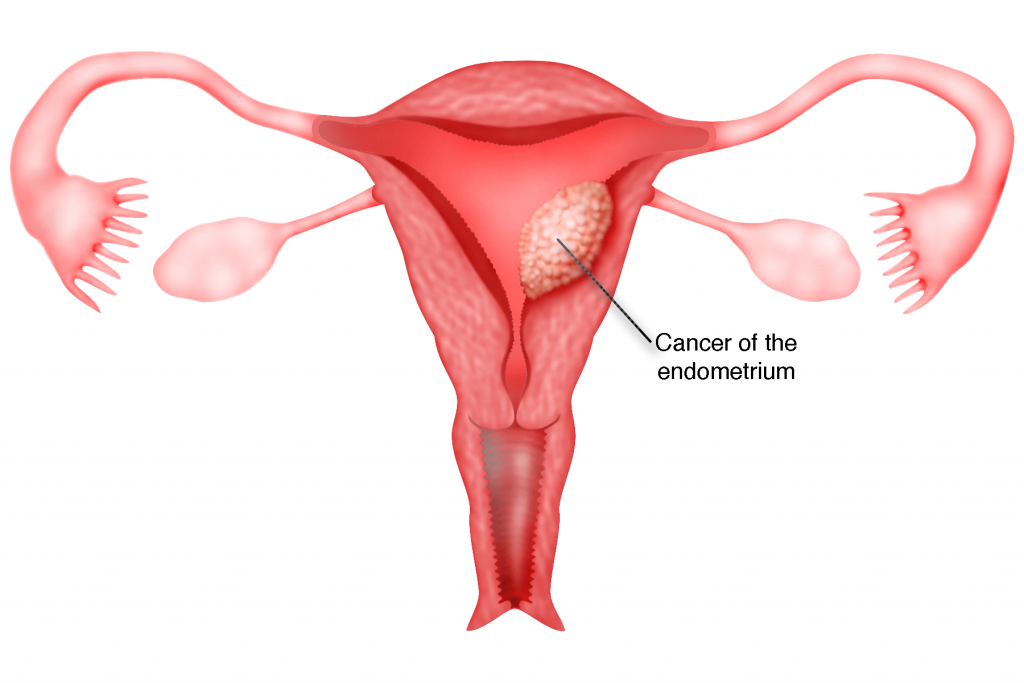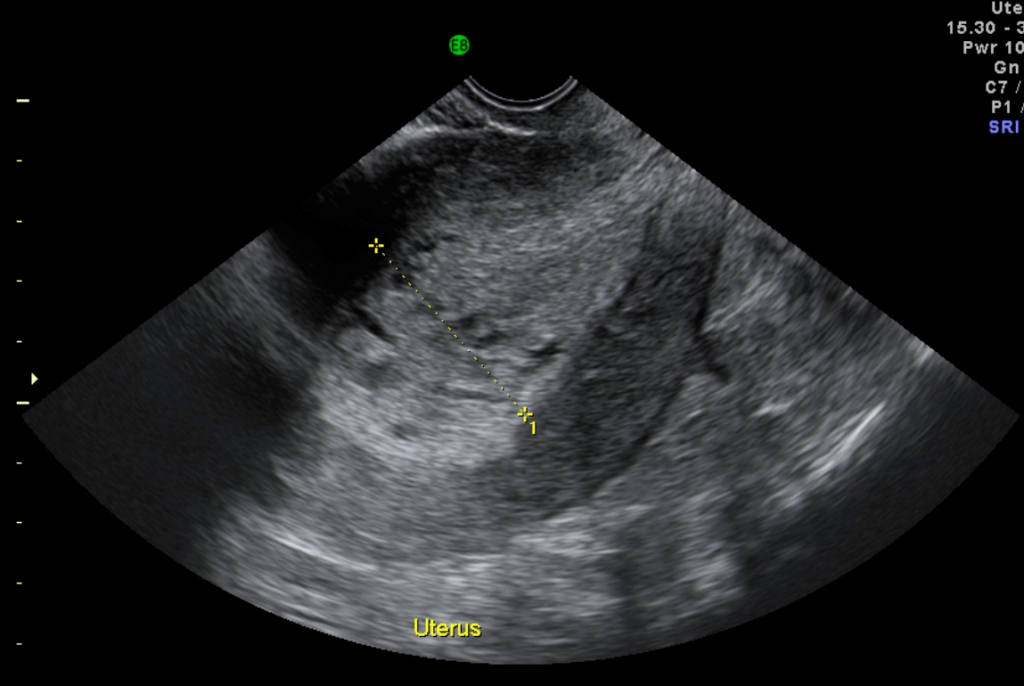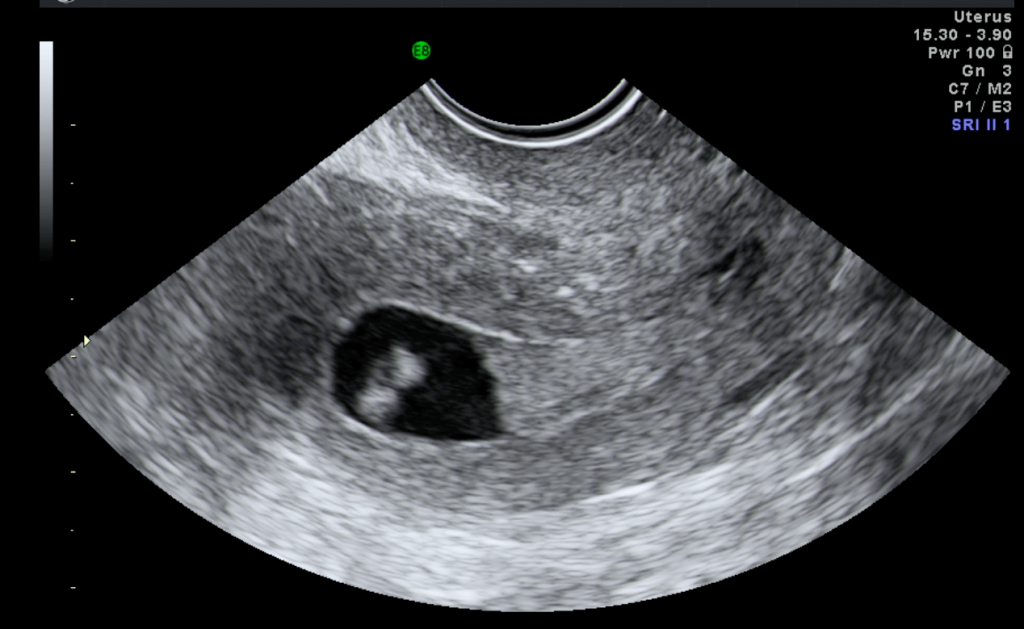Cancer of the endometrium is a cancer that develops from the inner lining of the uterus (endometrium). The most common endometrial cancer is carcinoma, which arises from the single layer of epithelial cells that line the endometrium, and forms the endometrial glands. Endometrial cancers are sometimes called uterine cancers. Although endometrial cancers are the most common type of uterine cancers, there are other types of uterine cancers as well.

Endometrial cancer is often detected at an early stage because women usually consult a doctor early when there is abnormal uterine bleeding. If endometrial cancer is discovered early, surgical treatment can cure the disease.
Incidence
The incidence of endometrial cancer is rising all over the world. It appears most frequently in women between the ages of 55 and 65, and is uncommon in women below the age of 40.
Cause
The cause of endometrial cancer is unknown. It may be a result of genetic mutation causing the endometrial lining cells to grow and multiply at an abnormal rate.
Risk factors
1) Increased exposure to oestrogen
The ovaries produce oestrogen and progesterone. An increase in level of oestrogen that is not balanced by progesterone may increase the risk of developing endometrial cancer. This happens to women
a) with polycystic ovarian syndrome. Oestrogen levels, in patients’ with this condition are high and they have a slightly increased risk of endometrial cancer.
b) who are obese. In obese women, the fat cells is a place for the conversion into oestrogen.
c) who start menstruation early (before 12 years of age) and/or have late menopause (after 55 years of age). These women have more menses in their lifetime. They are exposed to a longer duration of oestrogen and thus have a higher risk of endometrial cancer.
d) who have never been pregnant before. Women who have never been pregnant have a higher chance of developing endometrial cancer
2) Older Age
The risk of endometrial cancer is higher in older women than in younger women
3) Tamoxifen treatment for breast cancer
Women who are on tamoxifen for the treatment of breast cancer have a higher risk of endometrial cancer.
4) Diabetes
There is a slightly higher risk of developing endometrial cancer
5) Diet
A western diet high in fat may increase the risk of endometrial cancer
Symptoms
1) Vaginal bleeding and/or spotting after menopause
2) Prolonged periods
3) Bleeding in between periods
4) Lower abdominal pain or pelvic cramping.
5) Abnormal watery or blood stained vaginal discharge 6) Pain during sexual intercourse
Diagnosis
Irregular and prolonged menses are common symptoms around the time of menopause. These do not indicate endometrial cancer and gynecological examination will not reveal many abnormalities. The cervix will be normal and the uterus will also feel normal. There is a misconception that a normal pap smear precludes endometrial cancer.
A pap smear is only for the detection of cervical cancer and not for the detection of endometrial cancer.
Other investigations will include:
Transvaginal ultrasound
Ultrasonography will show the thickness of the endometrium. A thick endometrium and/or the presence of endometrial polyps may raise the suspicion of a endometrial cancer.


Endometrial biopsy
In endometrial biopsy, a fine tube is passed into the endometrial cavity (without anaesthesia) to aspirate some of the endometrial tissues for histopathological (g) examination. This procedure is done in the clinic.
Hysteroscopy
In hysteroscopy, a fine telescope is passed through the cervix and the uterine cavity to visualize the endometrial cavity. Biopsies can be taken from abnormal areas (see chapter 36).
Dilatation ad Curettage
A fine instrument is passed into the endometrial cavity to scrape of all the endometrial lining for assessment. This is usually performed under general anaesthesia and can be performed after a hysteroscopy.
Staging
Once the cancer has been diagnosed, tests will be conducted to determine the stage of the disease. These tests may include blood tests, chest X-ray and even a CT (computerized tomography) scan. However, the final staging of the disease is usually made only after surgery.
Stages of endometrial cancer:
Stage I cancer is found only in the uterus.
Stage II cancer is present in both the uterus and cervix.
Stage III cancer has spread beyond the uterus, but hasn’t reached the rectum and bladder. The pelvic lymph nodes may be involved.
Stage IV cancer has spread past the pelvic region and can affect the bladder, rectum and more distant parts of your body.
Treatment
Treatment will depend on the stage of the disease and the health of the patient.
Surgery
Surgery is the mainstay of the treatment for endometrial cancer. Surgery will involve the removal of the uterus (hysterectomy) and the ovaries as well as and the fallopian tubes (salpingo- oophrectomy). This surgery can be performed laparoscopically. (see chapter 33 and 34) During the surgery the pelvis and abdomen will be inspected to see whether there are any signs of cancer spread. Lymph nodes may be removed for testing for evidence of spreading of the cancer. In women who are in the early stage of cancer of the endometrium, surgery is sufficient. There is no need for chemotherapy or radiation.
Radiation
Radiation therapy is necessary in patients whose cancer has spread. Sometimes, even in early cancer, radiotherapy may be recommended to reduce the chances of recurrence. In women who are medically unfit to undergo surgery, radiation may be recommended. In advanced cancer, radiation may help in the control of cancer related pain.
Hormone therapy
Hormone therapy may be necessary, especially in women who have advanced cancer. The medication can be synthetic progesterone to increase the amount of progesterone in the body, or medication to reduce the amount of oestrogen in the body.
Chemotherapy
Chemotherapy may be necessary especially in advanced cancer of the endometrium.
Survival rates
The 5-year survival rates for endometrial adenocarcinoma following appropriate treatment are
Stage | 5 year survival rate |
|---|---|
1 | 75 – 90% |
2 | 69% |
3 | 47% – 58% |
4 | 0 – 17% |
Prevention
1) Maintain a healthy body weight
2) Exercise often
3) Use of birth control pills: Taking oral contraceptive pills even for 1 year decreases the risk of endometrial cancer.
4) Progesterone in Hormone replacement Therapy is important to reduce the risk of endometrial cancer
Summary
Cancer of the endometrium is a cancer that develops from the inner lining of the uterus (endometrium). Cancer of the endometrium is usually detected early because it presents with abnormal per vaginal bleeding. Diagnosis can be suspected during a transvaginal ultrasound and confirmed with a biopsy of the endometrium. Surgery (removal of the uterus and ovaries) is the mainstay of treatment. In advanced stages the patient may require radiotherapy and chemotherapy
